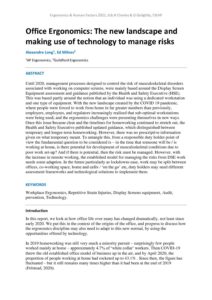| Document | Author Alexandre Long, Ed Milnes |
| Abstract Until 2020, management processes designed to control the risk of musculoskeletal disorders associated with working on computer screens, were mainly based around the Display Screen Equipment assessment and guidance published by the Health and Safety Executive (HSE). This was based partly around the notion that an individual was using a dedicated workstation and one type of equipment. With the new landscape created by the COVID 19 pandemic, where people were forced to work from home in far greater numbers than previously, employers, employees, and regulators increasingly realised that sub-optimal workstations were being used, and the ergonomics challenges were presenting themselves in new ways. Once this issue became clear and the timelines for homeworking continued to stretch out, the Health and Safety Executive published updated guidance, which distinguished between temporary and longer-term homeworking. However, there was no prescriptive information given on what temporary meant. To untangle this, from a responsible duty holder point of view the fundamental question to be considered is – in the time that someone will be / is working at home, is there potential for development of musculoskeletal conditions due to poor work set-up? And if there is potential, then the risk must be managed. However, with the increase in remote working, the established model for managing the risks from DSE work needs some adaption. In the future particularly as lockdowns ease, work may be split between offices, co-working space, home and cafés / ‘on the go’ etc, duty holders may need different assessment frameworks and technological solutions to implement them. |

